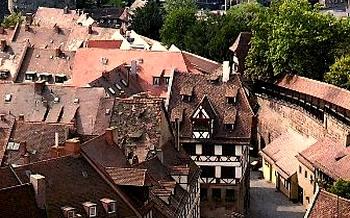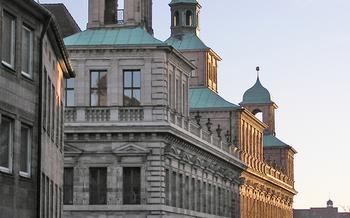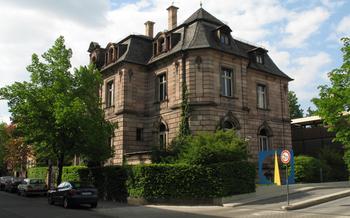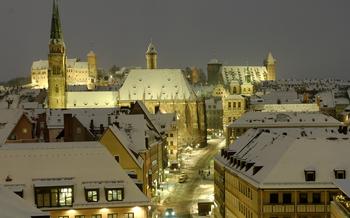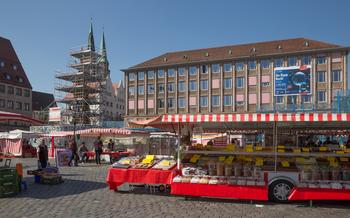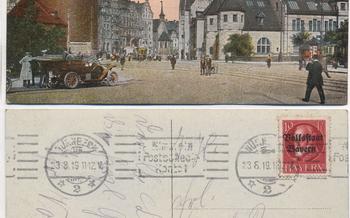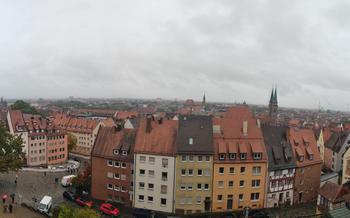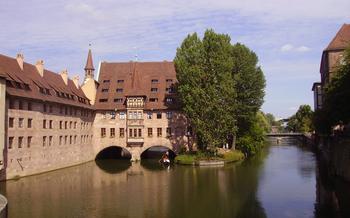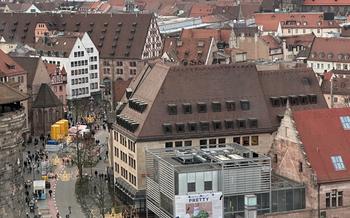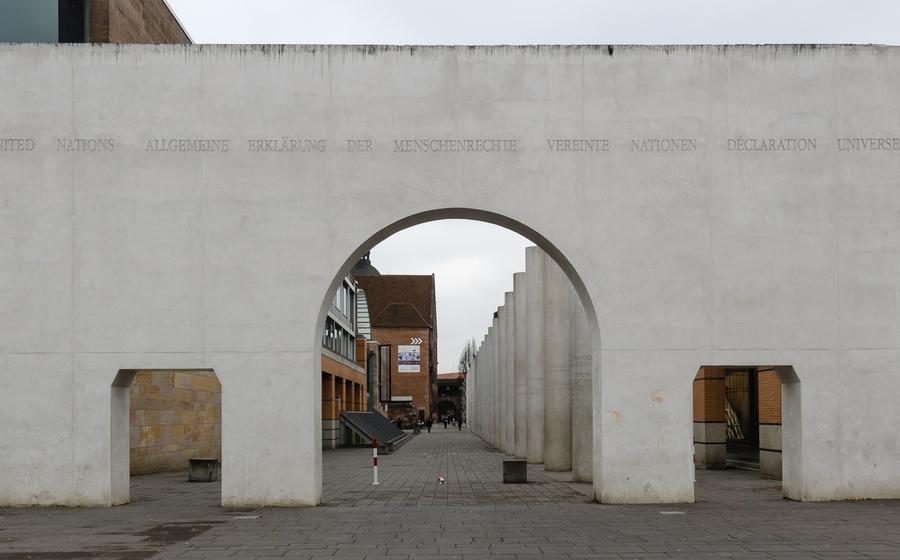
The Way of Human Rights (Straße der Menschenrechte)
- The Way of Human Rights: A Path to Reflect and Learn
- Location: A Historic Setting in the Heart of Nuremberg
- Interactive Stations: Engaging with Human Rights Concepts
- Historical Milestones: Tracing the Journey of Human Rights
- The Universal Declaration of Human Rights: A Landmark Document
- A Walk for All: Accessibility and Inclusivity
- Guided Tours: Enhancing the Experience with Local Insights
- Educational Resources: Learning Beyond the Path
- Human Rights Organizations: Advocating for Change
- Art and Human Rights: Creative Expressions of Advocacy
- Human Rights Festivals and Events: Raising Awareness and Celebrating Diversity
- Human Rights and Tourism: Responsible Travel Practices
The Way of Human Rights: A Path to Reflect and Learn
The Way of Human Rights or Straße der Menschenrechte, is more than just a historical monument; it's a journey of reflection and learning, inviting visitors to explore the essence of human rights and their profound impact on our world. This unique path, nestled in the heart of Nuremberg, Germany, holds immense significance as a testament to the indomitable spirit of humanity and our collective pursuit of justice, equality, and freedom.
Historical Significance: Unveiling the Story Behind the Creation of the Way of Human Rights
The Way of Human Rights was conceived in the aftermath of World War II, a period marked by unspeakable atrocities and the violation of fundamental human rights on a colossal scale. In 1987, the city of Nuremberg, forever etched in history as the site of the infamous Nuremberg Trials, embarked on a mission to create a lasting memorial to the victims of human rights abuses. The path, inaugurated in 1993, serves as a powerful reminder of the horrors of the past and a beacon of hope for a future where human rights are upheld and cherished.
Symbolism: Understanding the Monument's Design and the Significance of its Location
The Way of Human Rights is meticulously designed to convey a profound message through its symbolism and placement. The path, stretching over a distance of 8 kilometers, begins at the foot of the Nuremberg Castle, a historical landmark that once housed the Nazi regime. This symbolic starting point underscores the path's mission to confront the past and promote a culture of human rights.
The path is adorned with 27 stelae, each representing one of the articles of the Universal Declaration of Human Rights, adopted by the United Nations in 194These stelae, made of granite and bronze, feature powerful artistic representations that depict the essence of each article. The path culminates at the German National Museum, a repository of cultural and historical treasures that further enriches the visitor's experience.
Relevance: Exploring the Contemporary Importance of Human Rights and the Message Conveyed by the Path
The Way of Human Rights is not merely a historical relic; it resonates deeply with the contemporary world, where human rights violations continue to plague our societies. The path serves as a reminder that the fight for human rights is an ongoing struggle that requires our unwavering commitment.
By providing a platform for reflection and dialogue, the path challenges visitors to confront their own understanding of human rights, their responsibilities as citizens, and the role they can play in creating a more just and equitable world. It's a reminder that human rights are not just abstract ideals but essential principles that should guide our actions and shape our societies.
Personal Impact: Sharing Anecdotes and Experiences of Visitors Who Have Walked the Path
The Way of Human Rights has left an indelible mark on countless visitors who have walked its path. Visitors have shared powerful accounts of how the experience has transformed their perspectives, sparked meaningful conversations, and inspired them to take action in their own lives.
For some, the path has been a profound journey of self-discovery, leading them to recognize their own biases and privileges and to develop a deeper understanding of the struggles faced by others. For others, it has been a call to action, motivating them to get involved in human rights advocacy and to work towards creating a world where human rights are respected and protected for all.
Location: A Historic Setting in the Heart of Nuremberg
The Way of Human Rights is conveniently situated in the heart of Nuremberg, easily accessible by public transportation or on foot. The path begins at the Germanisches Nationalmuseum, a renowned museum dedicated to German art and cultural history. This starting point is significant as it highlights the intersection of human rights with Germany's past and cultural heritage.
Nuremberg holds a profound historical connection to human rights. The city was the site of the Nuremberg Trials, a pivotal moment in the establishment of international law and the prosecution of war crimes and crimes against humanity. Visitors can also explore the Nuremberg Palace of Justice, where the trials were held, and the Documentation Center Nazi Party Rally Grounds, which sheds light on the city's complex history during the Nazi era.
In the vicinity of the Way of Human Rights, visitors can find several other notable landmarks that complement their visit. The Nuremberg Castle, a majestic imperial fortress, offers breathtaking views of the city and a glimpse into its medieval past. The Albrecht Dürer House, the former residence of the renowned Renaissance artist, provides an intimate look into his life and work. These landmarks, when combined with the Way of Human Rights, create a comprehensive journey through Nuremberg's rich history and cultural heritage.
Interactive Stations: Engaging with Human Rights Concepts
The Way of Human Rights features 27 interactive stations, each dedicated to a specific human right. These stations are designed to engage visitors through various artistic representations, physical installations, and interactive elements.
The stations feature sculptures, mosaics, and other artworks that visually depict the essence of each right. Visitors can touch, listen, and interact with these artworks, creating a multisensory experience that enhances their understanding of the concepts.
At each station, visitors will find interactive elements that invite them to engage with the content. These elements may include touchscreens with multimedia presentations, audio recordings of personal stories, or hands-on activities that illustrate the challenges and triumphs related to each right.
For example, the station on the right to freedom of expression features a large metal sculpture of a megaphone, symbolizing the power of voice. Visitors can step up to the microphone and record their own messages, which are then played back through the sculpture, amplifying their voices and emphasizing the importance of free speech.
Another station, on the right to education, showcases a series of interactive screens that display stories of individuals from around the world who have overcome barriers to access education. Visitors can navigate through these stories and learn about the transformative power of education in promoting human rights.
Through these interactive stations, the Way of Human Rights provides a dynamic and engaging learning experience, encouraging visitors to reflect on their own rights, responsibilities, and the importance of standing up for human rights for all.
Historical Milestones: Tracing the Journey of Human Rights
The Way of Human Rights in Nuremberg not only commemorates the atrocities of the past but also celebrates the progress and milestones achieved in the global fight for human rights. The journey begins with the ancient origins of human rights, tracing its roots back to the earliest civilizations.
In particular, the Code of Hammurabi (1754 BC) and the Cyrus Cylinder (539 BC) are highlighted as foundational documents that established principles of justice, equality, and the rule of law. The path then explores the influence of philosophers and thinkers during the Enlightenment era, such as John Locke, Jean-Jacques Rousseau, and Thomas Paine, who laid the groundwork for modern human rights concepts.
The path also features significant international agreements and declarations that marked pivotal moments in the history of human rights. The Magna Carta (1215) is recognized for its role in limiting the power of the monarchy and establishing the principle that all individuals are subject to the law. The Geneva Conventions (1864-1949) are presented as groundbreaking treaties that set standards for the humane treatment of prisoners of war and civilians during armed conflicts.
These milestones serve as reminders of the long and arduous journey that humanity has undertaken to secure the fundamental rights and freedoms we enjoy today.
The Universal Declaration of Human Rights: A Landmark Document
The Way of Human Rights culminates in the Universal Declaration of Human Rights (UDHR), a landmark document that has profoundly shaped the global understanding and protection of human rights. Adopted by the United Nations General Assembly in 1948, the UDHR outlines a comprehensive set of fundamental rights and freedoms to which all human beings are entitled, regardless of their race, sex, nationality, religion, or any other status.
The UDHR consists of 30 articles, each addressing a specific right. These rights include the right to life, liberty, and security of person; the right to equality before the law; the right to freedom of thought, conscience, and religion; the right to freedom of expression; the right to peaceful assembly and association; and the right to work, education, and an adequate standard of living.
The UDHR has had a profound impact on international law. It has served as the foundation for numerous subsequent human rights treaties and conventions, and its principles have been incorporated into the constitutions and legal systems of many countries. The UDHR has also inspired the establishment of international human rights bodies, such as the United Nations Human Rights Council and the European Court of Human Rights.
Despite its universal recognition, the full realization of the rights enshrined in the UDHR remains a challenge in many parts of the world. However, the declaration continues to serve as a powerful symbol of hope and a reminder that all human beings deserve to be treated with dignity and respect.
A Walk for All: Accessibility and Inclusivity
The Way of Human Rights is designed to be accessible and inclusive to all visitors, regardless of their physical abilities or limitations. The path is wheelchair accessible, with ramps and elevators provided at each station. Braille signage and audio descriptions are available for visually impaired visitors. For those who are deaf or hard of hearing, sign language interpreters can be arranged upon request.
To ensure that everyone can understand and engage with the path's content, multilingual resources are provided. The stations are equipped with information panels in multiple languages, and guided tours are offered in various languages, including English, German, French, and Spanish.
The path also caters to families with children. Interactive games and activities are incorporated into the stations to make learning about human rights fun and engaging for younger visitors. Playgrounds and rest areas are located along the path, providing opportunities for families to take breaks and recharge.
Guided Tours: Enhancing the Experience with Local Insights
The Way of Human Rights offers guided tours that provide a deeper understanding of the history and significance of the path. These tours are led by knowledgeable local guides who share their insights and expertise, bringing the stories behind the path to life. Visitors can choose from a variety of tour options, including standard guided tours, thematic tours focusing on specific aspects of human rights, and even customized tours tailored to their interests.
Guided tours typically last for about 90 minutes and cover all 30 stations of the path. The guides provide detailed explanations of each station, including the historical context, the significance of the human rights addressed, and the artistic representations used. They also encourage visitors to ask questions and engage in discussions, creating a more interactive and personalized experience.
One of the highlights of the guided tours is the opportunity to learn about local perspectives on human rights. The guides often share personal stories and anecdotes related to the path and its messages, which helps visitors connect with the material on a deeper level. They also provide insights into the local history of human rights activism and the ongoing efforts to promote and protect human rights in Nuremberg and beyond.
Whether you're a history buff, a human rights advocate, or simply someone who wants to learn more about this important topic, a guided tour of the Way of Human Rights is highly recommended. The knowledgeable and passionate guides will enhance your experience and leave you with a deeper understanding of the path and its significance.
Educational Resources: Learning Beyond the Path
The Way of Human Rights in Nuremberg offers a wealth of educational resources to deepen your understanding of human rights. Their website provides comprehensive information, including detailed descriptions of each station, historical context, and interactive activities. You can also access a virtual tour of the path, allowing you to experience it from anywhere in the world.
For further reading, the website recommends a selection of books, articles, and reports on human rights topics. These resources cover a wide range of perspectives and provide in-depth analysis of human rights issues. Additionally, the path collaborates with local libraries and educational institutions to host workshops, seminars, and events on human rights. These events offer opportunities for dialogue, learning, and engagement with experts and activists.
By exploring these educational resources, you can continue your journey of learning and understanding beyond your visit to the Way of Human Rights. These resources will empower you to become a more informed and active advocate for human rights in your own community and globally.
Human Rights Organizations: Advocating for Change
Nuremberg is home to several human rights organizations that are actively involved in promoting and protecting human rights locally, nationally, and internationally. These organizations play a crucial role in raising awareness, advocating for change, and providing support to those whose rights have been violated.
One notable organization is the Nuremberg Human Rights Center, which works to promote human rights education, research, and advocacy. Through its various initiatives, the center aims to foster a culture of respect for human rights and contribute to the development of a more just and equitable society.
Another prominent organization is the Bavarian Red Cross, which has a strong focus on humanitarian aid and disaster relief. In addition to providing emergency assistance, the Red Cross also works to promote human rights and peace by supporting vulnerable communities and advocating for their rights.
These organizations, along with many others, contribute to Nuremberg's reputation as a city that is committed to upholding human rights and promoting a culture of respect and understanding. Visitors to the city can learn more about these organizations and their work by visiting their offices or participating in their events and activities.
Art and Human Rights: Creative Expressions of Advocacy
Nuremberg's dedication to human rights extends beyond the Way of Human Rights path. The city is home to a vibrant arts scene that often intersects with human rights advocacy. Art exhibitions, murals, and street art serve as powerful mediums to raise awareness about various human rights issues and promote social change.
One notable exhibition is the "Human Rights Art Festival," held annually at the Kunsthalle Nürnberg. This festival showcases works by local and international artists who explore human rights themes through their art. The festival provides a platform for artists to express their perspectives on social justice, equality, and the human condition.
Nuremberg's streets also serve as a canvas for human rights art. Murals depicting human rights symbols or messages can be found in various neighborhoods. One prominent example is the "Wall of Hope" mural, created by local artist Birgit Kinder. The mural features colorful images and messages that celebrate diversity, inclusion, and the struggle for human rights.
Local artists also use their work to promote human rights through workshops, talks, and community projects. For instance, the artist collective "Nürnberg for Human Rights" organizes events that bring together artists, activists, and the community to engage in discussions about human rights issues and find creative ways to advocate for change.
By integrating art into its human rights advocacy efforts, Nuremberg creates a dynamic and engaging environment where people can connect, learn, and be inspired to take action for a more just and equitable world.
Human Rights Festivals and Events: Raising Awareness and Celebrating Diversity
Nuremberg hosts a variety of human rights festivals and events throughout the year, providing a platform for raising awareness, celebrating diversity, and fostering a sense of community. These events offer a unique opportunity for visitors to engage with locals, learn about different cultures, and experience the city's vibrant human rights scene.
One of the most significant events is the annual Nuremberg International Human Rights Film Festival, which showcases films that explore human rights issues from around the world. The festival attracts filmmakers, activists, and audiences from diverse backgrounds, creating a space for dialogue, reflection, and inspiration.
Another highlight is the Nuremberg Human Rights Festival, a week-long celebration featuring art exhibitions, workshops, concerts, and discussions on human rights themes. The festival brings together local and international artists, activists, and experts to share their perspectives and engage with the public.
These events not only raise awareness about human rights but also provide a platform for cultural exchange and community building. Visitors are encouraged to participate in these events, attend performances, engage in discussions, and connect with like-minded individuals. By doing so, they can contribute to a more inclusive and vibrant human rights culture in Nuremberg.
Human Rights and Tourism: Responsible Travel Practices
As you embark on your journey to Nuremberg, it's important to consider the ethical implications of your travel choices. Responsible tourism involves respecting human rights, supporting local communities, and minimizing your environmental impact. Here are some tips to ensure your visit is both enjoyable and ethical:
-
Choose Accommodations that Uphold Human Rights: Opt for hotels, guesthouses, or vacation rentals that prioritize fair labor practices, sustainability, and respect for local cultures. Look for establishments that are committed to paying their employees a fair wage and providing them with safe working conditions.
-
Support Local Businesses that Promote Human Rights: When shopping for souvenirs or dining out, seek local businesses that actively support human rights initiatives. Look for shops that sell fair trade products or restaurants that source their ingredients from local farmers. Your purchases can make a positive impact on the community.
-
Minimize Your Environmental Footprint: Be mindful of your environmental impact by reducing waste, conserving energy, and choosing sustainable transportation options. Walk, bike, or use public transportation instead of renting a car whenever possible. Support local initiatives that promote sustainable tourism practices.
-
Engage with Local Communities: Take the time to interact with locals and learn about their experiences and perspectives. Attend community events, visit local markets, and participate in cultural activities. This will not only enrich your travel experience but also foster understanding and respect.
By practicing responsible tourism, you can contribute to a more just and sustainable world while enjoying all that Nuremberg has to offer.
